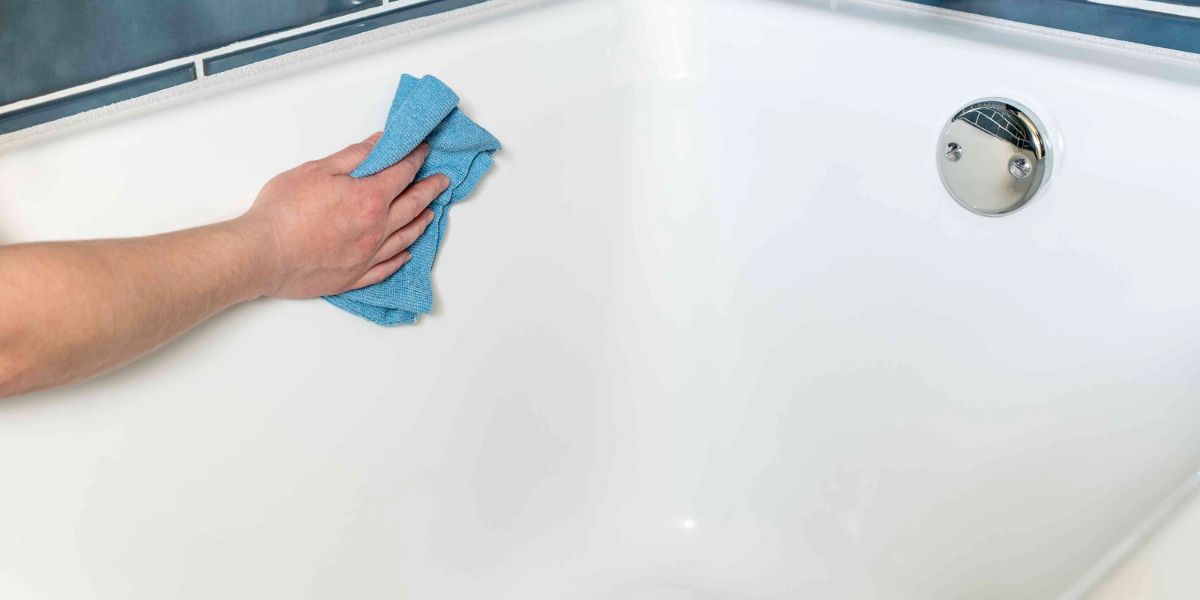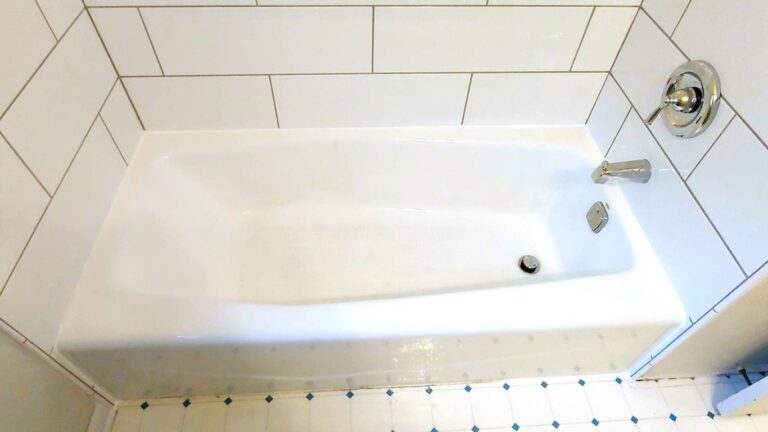How to Clean an Acrylic Bathtub Without Scratching?
Keeping your acrylic bathtub looking shiny and new is important. But acrylic is prone to getting scratched if you clean it the wrong way. Believe me, I’ve been there! When we moved into our house, the previous owners had badly scratched up the tub.
No amount of scrubbing would get rid of the cloudy, scratched appearance. I was determined not to make the same mistakes, so I did my research to find the best way to clean an acrylic tub without causing swirl marks or scratches.
After testing different techniques and products, I’ve found a method that works beautifully to keep our acrylic tub sparkling. Below, I’ve shared everything I’ve learned about safely cleaning acrylic bathtubs without that dreaded scratching. From the best cleaners and tools to use, to techniques for removing stubborn stains, you’ll have all the knowledge you need to keep your tub looking pristine.
Why It’s Important to Clean Acrylic Bathtubs Properly
Acrylic plastic has a smooth, glossy finish that looks wonderful when new. But it is prone to fine scratches, especially from abrasive cleaners or scrubbers. Once scratched, the tub’s surface becomes cloudy and rough, making it harder to keep clean.
Bacteria and mildew can take hold in scratched areas, causing stains and odors. The key is to use only non-abrasive cleaners and soft scrubbing pads to avoid scratching that glossy surface. Proper care will keep your tub shining like new for years.
Avoid Abrasive Cleaners and Scrubbers
When cleaning your acrylic tub, the first rule is to avoid anything abrasive that could scratch the surface. That means no scouring powders like Comet or Ajax. The gritty particles in these cleaners are like sandpaper on acrylic. I learned this the hard way after mistakenly using Comet to remove some soap scum. I was left with fine scratches all over the bottom of the tub.
You also want to avoid abrasive scouring pads made of stiff plastic, nylon, or natural fiber. Even those green and yellow “scrubby” sponges are too rough for acrylic. Instead, use a very soft sponge, microfiber cloth, or one of those rubber fingers made specifically for tubs. The softness prevents tiny scratches as you clean.
Read more: Do Acrylic Bathtubs Need Insulation?
Best Cleaners for Acrylic Tubs

Through trial and error, I’ve found some great homemade cleaners that remove dirt, soap residue, and mineral deposits from my acrylic tub safely and effectively. Must see my guide about cleaning acrylic tubs with Magic cleaner.
Warm water mixed with a small amount of mild dishwashing liquid works wonders for routine cleaning. I keep a spray bottle filled with the soapy solution to use after every bath. Spray it on and let it sit briefly before wiping it down with a soft sponge. The grease-cutting power dissolves body oils and residual soaps without dulling the shiny surface.
For tackling soap scum and hard water buildup, I mix equal parts warm water and distilled white vinegar. The diluted vinegar dissolves the scummy residue and restores the tub’s sparkle. I apply it with a soft cloth and let it sit for 5-10 minutes before rinsing. Just don’t use vinegar on marble surfaces as it can etch the marble.
Non-acetone nail polish remover is amazing for getting rid of those rusty “bathtub rings” caused by hard water and iron deposits. I pour some on a cotton ball and rub it into the stains. After a few minutes, I can wipe them right off with no scratches. The acetone remover is too harsh, so be sure to use the non-acetone type.
In a pinch, I’ve also had success mixing a solution of 90% water with 10% isopropyl rubbing alcohol. This works to cut through just about any oily, soapy, or hard water stains without dulling the tub’s finish. Just never use full-strength alcohol as it can damage the acrylic over time.
How to Clean an Acrylic Bathtub Without Scratching?
Using the right cleaners is important, but so is how you apply them. Always test any cleaning solution in an inconspicuous spot before using it throughout the tub. I chose a corner down by the drain.
Apply the cleaner with a damp soft cloth or sponge using gentle, circular motions. Rub too hard or scrub back and forth, and you risk marring that glossy finish. Easy does it.
Thoroughly rinse the tub with warm water after cleaning to remove any residue. The leftover cleaner that dries on the surface can leave streaks. I give the tub one final wipe down with a microfiber cloth to prevent water spots as it dries.
Be mindful not to drag objects across the bottom of the tub. Items like bathmats or shower poufs can scratch the surface if slid around. Likewise, avoid leaning or pressing heavily on the tub with your elbows or knees during cleaning. The added pressure can create fine swirl marks over time.
How to Maintain the Shine Of Acrylic Tub Bathtub?
To make cleaning easier, I apply a thin coat of acrylic tub polish about once a month. This protective sealant helps prevent soap scum, minerals, and other deposits from building up. As an added bonus, it fills in tiny scratches and swirls in the surface, helping restore that glossy just-installed sheen. I use a product called HOPE’S Perfect Tub Polish and have been really pleased with the results.
It also helps to keep a dedicated sponge or soft scrubber for only my bathtub cleaning. Using the same sponge I clean the kitchen sink or countertops with can transfer grit and chemicals that scratch or cloud the tub’s surface.
I always try to wipe down the tub fully after each use. This quick maintenance prevents soap scum from sticking and hard water stains from building up. It takes 30 seconds but saves me scrubbing later. For best results, thoroughly dry the tub with a soft cloth after rinsing.
Maintaining Your Investment
Acrylic bathtubs offer a great combination of durability, affordability, and easy cleaning. Unlike porcelain, acrylic withstands bumps and has some flexibility. But unlike fiberglass, it retains its beautiful, glossy look with proper care. By using non-abrasive cleaners and gentle techniques, your tub can stay sparkling and scratch-free for many years.
I hope these acrylic tub cleaning tips help you keep yours looking fabulous with minimal effort. With some simple maintenance and my recommended methods, you can soak in a tub that looks as immaculate as the day it was installed. Here’s to many relaxing, rejuvenating baths in a pristine oasis!
Frequently Asked Questions
What are some common causes of scratches in acrylic tubs?
The most common causes of scratching are using abrasive cleaners or scouring pads, dragging objects across the surface, and applying too much pressure while scrubbing. Even jewelry can scratch acrylic if it rubs against the surface.
How can I remove light scratches from my tub?
For minor scratching, use a high-quality acrylic tub polish like Hope’s Perfect Tub Polish. The polishing compounds help minimize the appearance of fine scratches. Avoid polishes with gritty abrasives that could cause more scratching.
What is the best way to clean soap scum off an acrylic tub?
Mix a solution of equal parts warm water and white vinegar. Spray it on the soap scum and let sit for 5-10 minutes before wiping it away. The vinegar dissolves sticky soap residue without damaging the acrylic surface.
What should I avoid using on my acrylic tub?
Avoid any abrasive cleaners like Comet or Ajax, scouring powders, stiff nylon scrubs, steel wool, and abrasive sponges. Also, avoid full-strength acetone or isopropyl alcohol as these can dull the finish.
How can I restore a badly scratched tub?
For severe scratching or damage, professional re-surfacing is recommended. Companies can sand down the worn layer and re-spray a fresh glossy acrylic finish. DIY re-glazing kits are also available but require caution.
Should I re-caulk around my acrylic tub?
Yes, re-caulking helps waterproof the seam and prevent leaks. Use a flexible, mildew-resistant silicone caulk designed for damp areas. Carefully remove all the old caulk before re-applying fresh caulk.
How often should I clean my acrylic tub?
Ideally, wipe down the tub after every use to prevent soap scum and mineral buildup. Deep clean the tub weekly with recommended cleaners and soft scrub pads. Re-apply a protective polish layer monthly.

William J. Bullock is a licensed plumber with over 15 years of experience installing and repairing bathtubs. He runs his own plumbing company in Greenville and serves residential and commercial clients. William is dedicated to providing honest, transparent advice to help homeowners make informed decisions about their bathroom renovations.
He has established expertise in selecting bathtubs, planning custom installations, diagnosing issues, and completing repairs. William aims to share practical tips and reliable recommendations based on extensive hands-on work. When he isn’t on a job site, William enjoys spending time with his family and volunteering at local community events. He takes pride in delivering quality service and enjoys helping people upgrade their homes.







